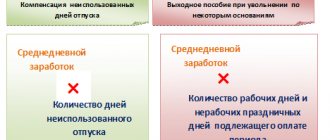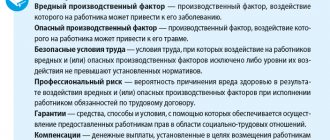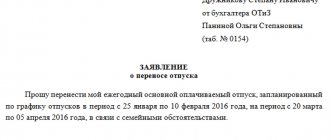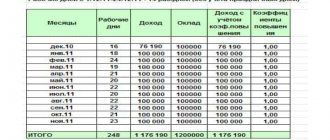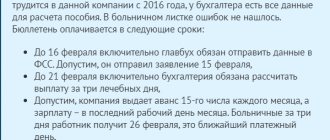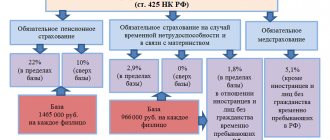Duration of vacation: understanding the terminology
According to Art.
120 of the Labor Code of the Russian Federation, annual basic paid leave is provided in calendar days, therefore, it does not matter what day according to the calendar and schedule the vacation time falls on. Its minimum duration is 28 calendar days (Article 115 of the Labor Code of the Russian Federation). But there are employees who are entitled to extended leave: disabled people, civil servants, teaching staff, minors, etc. The duration of leave does not include only non-working holidays, which are defined in Art. 112 Labor Code of the Russian Federation. So, for example, if an employee takes vacation from June 1 to June 28, then he needs to leave the vacation not on June 29, but on June 30, since the vacation days include a non-working holiday - June 12. In this case, the order to grant leave to the employee is completed simply: in the line “Annual paid leave” 28 calendar days are indicated, and in the period “from ... to” the dates from June 1 to June 29 are written.
Rescheduled weekends, which are included in the vacation duration, should not be confused with non-working holidays. Please note how the transfer of holidays in 2020 is established.
How many days of vacation are allowed per year?
How many days of vacation are allowed per year?
As a general rule, the number of paid vacation days per year must be at least 28 (Article 115 of the Labor Code of the Russian Federation). Is this 28 calendar days or working days? Annual basic paid leave is calculated in calendar days (Article 120 of the Labor Code of the Russian Federation). That is, for each working year, the employee is entitled to 28 calendar days.
Dividing vacation into parts
An employee does not have to use all 4 weeks of his/her allotted vacation at one time. Leave can be divided by agreement between the employee and the employer. The division of vacation into parts according to the Labor Code of the Russian Federation must be carried out in such a way that the duration of at least one of the parts is at least 14 calendar days (Article 125 of the Labor Code of the Russian Federation). If this condition is met, the duration of other parts of the vacation can be an arbitrarily small number of days, including 1 or 2 days.
How long is an employee’s vacation, including weekends and holidays?
Weekends falling within the vacation period are taken into account when calculating its duration and are subject to payment. Let's explain with an example. Manager Ivanov A.K. wrote an application for leave for the period from May 31 to June 6, 2021. June 5th and 6th are days off. Accordingly, the employee must be given leave for 7 days and all 7 days must be paid.
Unlike regular weekends, holidays and non-working days are not included in the duration of vacation and are not paid (Article 120 of the Labor Code of the Russian Federation). Let's go back to the example above. If Ivanov A.K. writes an application for June 7-14 - 8 calendar days, only 7 calendar days will be counted and paid for vacation. Because June 12 is a holiday (Article 112 of the Labor Code of the Russian Federation).
Vacation: number of days according to law and local regulations
The specified duration of vacation - 28 calendar days - is the minimum according to the Labor Code of the Russian Federation. And the employer, on his own initiative, can establish paid leave of longer duration for his employees. The number of additionally provided paid vacation days (in addition to 28) must be specified in the collective agreement, local regulations of the organization (for example, internal labor regulations) or directly in employment contracts with employees.
It is important that the costs of paying for such additional vacation days cannot be taken into account for profit tax purposes (clause 24 of article 270 of the Tax Code of the Russian Federation). Also, personal income tax will need to be withheld from the amount of their payment and insurance premiums will be charged (clause 2 of Article 226 of the Tax Code of the Russian Federation, clause 1 of Article 420 of the Tax Code of the Russian Federation).
At the same time, certain categories of employees are required by law to be granted longer vacations. Read below about how many days of vacation they are entitled to per year.
Extended leave under the Labor Code 2020/2021: how many days
Who has the right to apply for extended basic leave and how many days of leave should be provided to these persons is indicated in the table.
| Category of workers | Number of vacation days according to the Labor Code and other legislative acts |
| Workers under 18 years of age | 31 calendar days. Leave must be granted at any time convenient for the minor (Article 267 of the Labor Code of the Russian Federation) |
| Working disabled people with any disability group | At least 30 calendar days (Article 23 of Law No. 181-FZ dated November 24, 1995) |
| Teaching staff | 42 or 56 calendar days depending on the position held and the type of educational organization where the teacher works (Article 334 of the Labor Code of the Russian Federation, clause 3, part 5, article 47 of the Law of December 29, 2012 No. 273-FZ, Appendix to the Decree of the Government of the Russian Federation dated May 14, 2015 No. 466) |
| Researchers with an academic degree | — 48 working days for doctors of science; — 36 working days for candidates of science. The specified extended leaves are provided to scientific workers holding full-time positions in a scientific institution (organization) financed from the federal budget (Resolution of the Government of the Russian Federation of August 12, 1994 No. 949) |
| Workers working with chemical weapons | 56 or 49 calendar days depending on the group of work to which the employee’s activities are assigned. The assignment of work to the first or second group depends on the degree of their danger (Article 1, 5 of the Law of November 7, 2000 No. 136-FZ) |
| Workers of professional emergency rescue services and units | 30, 35 or 40 days, depending on the length of continuous work experience in professional emergency rescue services and units (Clause 5, Article 28 of Law No. 151-FZ of August 22, 1995) |
| Health care workers at risk of human immunodeficiency virus infection | 36 working days for employees of healthcare organizations diagnosing and treating HIV-infected people, as well as persons whose work involves materials containing the human immunodeficiency virus, taking into account additional annual leave for work in hazardous working conditions (clause 4 of the Government Decree RF dated 04/03/1996 No. 391) |
| State civil servants | 30 calendar days (Part 3 of Article 46 of the Law of July 27, 2004 No. 79-FZ) |
| Prosecutors, scientific and teaching staff of the prosecutor's office | 30 calendar days excluding travel time to the place of rest and back in the general case (clause 1 of article 41.4 of the Law of January 17, 1992 No. 2202-1). |
| Employees of the Investigative Committee serving in areas other than those with special climatic conditions | 30 calendar days excluding travel time to the place of rest and back in the general case (Part 1 of Article 25 of the Law of December 28, 2010 No. 403-FZ). |
Additional leave
Some employees, in addition to the main leave (standard or extended), are also entitled to additional leave. You can read about such a vacation in a separate article.
How many days is “northern” vacation according to the law?
How many days does a northerner's vacation last? Usually more than for non-northern workers. After all, “northerners”, firstly, are provided with basic annual paid leave - of standard duration or extended in the above cases. And secondly, they are granted additional leave (Article 321 of the Labor Code of the Russian Federation). For workers who work:
– in the regions of the Far North – 24 calendar days; – in areas equated to the regions of the Far North – 16 calendar days; - in other regions of the North, where the regional coefficient and percentage increase in wages are established - 8 calendar days (Article 14 of the Law of the Russian Federation of February 19, 1993 No. 4520-1). By the way, both regular annual paid vacations and extended, as well as additional “northern” vacations can be provided to employees in advance (Article 122 of the Labor Code of the Russian Federation).
Source: glavkniga.ru
02.26.2021, 14:51 Subscribe to the magazine
Vacation experience: what is included in it?
All rules for determining length of service giving the right to annual paid leave are laid down in Art. 121 Labor Code of the Russian Federation. And here it is important to pay attention to the fact that it includes not only the time of actual work, but also periods when the employee did not actually work, but retained his place of work (position).
Also in Art. 121 of the Labor Code of the Russian Federation specifies the time of unpaid leave provided at the request of an employee, not exceeding 14 calendar days during the working year. This rule means that 14 days are always included in the length of service giving the right to annual paid leave, and anything that exceeds these 14 days delays the end of the working year. This is also stated in the Letter of Rostrud dated June 14, 2012 No. 854-6-1.
In addition to the above-mentioned cases, the length of service that gives the right to annual basic paid leave includes: time of forced absence in the event of illegal dismissal or suspension from work and subsequent reinstatement to the previous job; the period of suspension from work of an employee who did not undergo a mandatory medical examination through no fault of his own, and other periods. This topic is discussed in more detail in the article Vacation experience: how to determine in various situations.
Leave without pay
Leave without pay comes in different forms. There are those that are provided upon a written application from the employee with the consent of the employer. And there are either categories of employees or certain life situations when, at the written request of the employee, the employer is obliged to provide a certain number of days of vacation without pay. These norms are reflected in Art. 128 Labor Code of the Russian Federation.
For family reasons and other valid reasons, an employee, upon his written application, may be (that is, in this situation, the employer has the full right to refuse) granted leave without pay, the duration of which is determined by agreement between the employee and the employer.
At the same time, the employer is obliged, based on a written application from the employee, to provide leave without pay:
- participants of the Great Patriotic War - up to 35 calendar days per year;
- for working old-age pensioners (by age) - up to 14 calendar days per year;
- parents and wives (husbands) of military personnel, employees of internal affairs bodies, the federal fire service, etc. - up to 14 calendar days a year;
- for working disabled people - up to 60 calendar days per year;
- employees in cases of the birth of a child, marriage registration, death of close relatives - up to 5 calendar days. Please note that the period during which an employee can exercise his right to write an application for such leave is not defined. The facts themselves matter. Therefore, when submitting unpaid leave in this case, the employer must check the occurrence of events: for example, was the birth of a child a legal fact and did the employee write a written statement?
Questions often arise about how to determine the working year for part-time workers. In this case, you need to focus on Art. 121 of the Labor Code, it states that the length of service giving the right to leave includes not only the time of actual work, but also the time when the employee did not actually work, but the work time was retained for him. In addition, Art. 93 of the Labor Code of the Russian Federation indicates that part-time work does not entail for employees any restrictions on the duration of the annual basic paid leave, calculation of length of service and other labor rights?
Calculate vacation pay automatically and without errors
To learn more
Another common question when applying for vacation pay: is it worth including in the length of service that gives the right to annual leave the period when the employee was on parental leave, but at the same time working part-time? Working part-time while on parental leave entitles the employee to leave. But there is one caveat: you cannot provide parental leave and annual basic paid leave at the same time. And this norm is reflected in the Resolution of the Plenum of the Armed Forces of the Russian Federation dated January 28, 2014 No. 1.
Therefore, if a part-time employee during parental leave expresses a desire to go on annual basic paid leave, the employer needs to do the following:
- take from the employee an application to interrupt parental leave (and if the child is under 1.5 years old, then also an application to terminate the payment of child care benefits before reaching the age of 1.5 years);
- issue an order (in any form) to interrupt parental leave and terminate the provision of benefits;
- accept the employee’s application for annual basic paid leave;
- issue a leave order;
- after the vacation, take the employee’s application again with a request to provide parental leave until the child reaches the age of 3 years.
Why do employers need this?
“This is largely a gesture of despair,” Vladimirskaya replies. — Nobody wants to pay for an employee not working. But there are so few quality professionals that when such a valuable employee burns out, it is better to let him go to sabbatical than to lose him forever. However, companies, of course, will never talk about this, but will tell you how much they value their employees and how they are ready to invest in their personal development.”
“The usual story of the sabbaticals is that long-term plans end badly,” the expert continues. “You know, it’s like returning to your family when everything was bad there.” Then you forgot all these grievances and returned to your loved one, and they all come out. About a year ago there was a big study on LinkedIn that people who go to Sabbatical then still leave the company within three years after returning.”
However, there is other scientific evidence that suggests that an employee’s performance can actually improve after the sabbatical. A recent comparison of 129 university professors who took sabbaticals with an equal number of colleagues who did not showed that the former had significantly reduced stress levels and increased psychological resources, and this effect persisted for a long time. Another survey of 61 NGO leaders found that many of them improved their leadership skills and generated ideas more effectively after the sabbaticals.
The presence of a sabbatical program in a company can give it bonuses in the labor market. “In the battle for talent, a new weapon is needed, the promise of paid and unpaid leave could be a good option,” writes Anna Schmidt, CEO of the recruiting company Career Partners International. Stories about employee sabbaticals also have a PR effect - it’s not for nothing that companies are so willing to post them on the Internet.
It is important to note that when leaving for sabbatical, employees, as a rule, sign an obligation not to leave the company during this period (and for some time after). Otherwise, they will have to return the money to the company (if the sabbatical was paid) and also pay a penalty. So companies are not afraid of losing an employee because of sabbatical, at least not right away.
What do you need to know about holiday entitlement?
Employers should adhere to the basic rule - paid leave must be provided to the employee annually, because this is required by the Labor Code.
At the same time, in Art. 124 of the Labor Code of the Russian Federation contains the following clause: “In exceptional cases, when the provision of leave to an employee in the current working year may adversely affect the normal course of work of an organization or individual entrepreneur, it is allowed, with the consent of the employee, to transfer the leave to the next working year. In this case, the leave must be used no later than 12 months after the end of the working year for which it is granted.”
The right to use vacation for the first year of work arises for the employee after six months of his continuous work with the employer, although by agreement of the parties it can be granted earlier. Some employers find this definition misleading. They reason like this: the employee can indeed write a statement, but the employer has the right to decide whether he will let him go on vacation or not. From a legal point of view, after six months of work, the employee has every right to write an application for leave for all 28 days, and the employer is obliged to provide him with this leave.
Leave for the second and subsequent years of work can be granted at any time of the working year in accordance with the order of provision of annual paid leave established by the employer.
Is this paid?
Differently. Some companies that can afford it pay sabbatical in whole or in part to their employees. For example, Intel pays 100% of the regular salary during this period, Citi - 25%. And the American software developer HubSpot gives its employees, who go on a fully paid four-week sabbatical, another $5,000 for personal expenses at a time.
But such generosity is still quite rare in the Western corporate world, Alena Vladimirskaya, the creator of the job search service Facancy and the Alena Vladimirskaya Career Laboratory, explained to a Forbes Life correspondent. “There are only two or three dozen companies in the world that make classic paid sabbaticals. This is what they say, they are completely mad from fat, from a lot of money. Because actually, it’s a very expensive process,” she said.
Deloitte offers its employees unpaid sabbaticals for a period of one month and “for any reason” (along with paid 3-6 months “for the purpose of personal or professional growth”). In Japan, the country's largest airline, All Nippon Airways, introduced an unpaid sabbatical program earlier this year - although it promises employees a one-time payment of 200,000 yen ($1,930). Interestingly, ANA does not object if pilots try to work for competitors during their year-long “time off.”
The availability of payments, as well as other conditions, are discussed when agreeing on the sabbatical with the employer. As a rule, this is not an easy process, because companies, no matter what they write in their PR materials, are in fact not at all eager to pay their employees paid time off. They are driven to this not by altruism, but by completely pragmatic considerations.
- Bonuses, wine, vacation: companies around the world began to look for ways to combat employee burnout
- Almost a third of Russians decided to give up their summer vacation
- Traveling during a pandemic: where Russian residents want to go on vacation in 2022
How to properly divide your vacation into parts?
In the vacation schedule, employers often indicate parts of the vacation. The norms of ILO Convention No. 132, namely Art. 8 allow this: “The division of annual leave with pay may be authorized by the competent authority or other appropriate authority in each country.”
In Part 1 of Art. 125 of the Labor Code of the Russian Federation states that, by agreement between the employee and the employer, annual paid leave can be divided into parts, and at least one of the parts of this leave must be at least 14 calendar days. Often the employer shows exactly this breakdown in the vacation schedule - 14 days and 14 days. Seeing this, the inspector from the GIT begins to ask questions. The employer has nothing to fear if he has “safety net” in the form of an agreement between the parties. If there are no agreements, then he may be brought to administrative liability under Part 1 of Art. 5.27 Code of Administrative Offences.
The continuous part of the annual paid leave (14 days), which is mentioned in paragraph 2 of Art. 8 of the ILO Convention, is granted and used no later than within one year, and the balance of annual paid leave no later than within 18 months after the end of the year for which the leave is granted.
In Art. 9 of ILO Convention No. 132 specifies that “any part of annual leave in excess of the established minimum duration may be deferred, with the consent of the employee, for a period exceeding that specified in paragraph 1 of this Article, but not exceeding certain separately established limits.”
If the employer violated the law and for some reason the employees were not given vacations for several years, then upon dismissal of these employees, the employer is obliged to pay them compensation for all unused vacations (Article 127 of the Labor Code of the Russian Federation). The concept of “burnt out” does not exist for a vacation.
Letter of Rostrud dated 06/08/2007 No. 1921-6 also recalls the preservation of the right to use all due annual paid leaves: “Annual leaves for previous working periods can be provided either as part of the leave schedule for the next calendar year, or by agreement between the employee and the employer.” .
At the time of inspection, the State Tax Inspectorate usually always requests a vacation schedule, while asking for employees’ personal cards (T-2) selectively. And we need to remember this. If an employer leaves a violation in the form of vacation arrears on his personal card, he can avoid problems, and if he enters the entire debt into the vacation schedule, then he actually voluntarily admits to violations.
Can be divided into parts
The law does not require the employer and employee to use the entire period of paid rest at once. It can be divided into parts. But only in such a way that at least one part has at least 14 days. Obviously, the standard 28 working days are conveniently divided into two equal parts in this way. This usually suits both the employees themselves and the employers. But if a person needs to use all the rest time allotted to him at once, the employer is obliged to provide it in full and does not have the right to demand a division of vacation time. Also, the employee does not always want to divide the rest into two halves of 14 days. Sometimes one half lasts two weeks, and the remaining days are scattered in a convenient order for a person, at least one day at a time. This is not prohibited by law.
Transferring vacation legally
The vacation schedule is mandatory for both the employer and the employee (Article 123 of the Labor Code of the Russian Federation). Therefore, both of them must follow it. All cases of transferring vacation are determined by law - in Art. 124 Labor Code of the Russian Federation. These cases include:
- temporary disability of the employee;
- the employee performs state duties during his annual paid leave, if the labor legislation provides for exemption from work for this purpose;
- in other cases provided for by labor legislation and local regulations. For example, in the internal labor regulations in the “Rest time” section, a clause may be included that, upon a written application from the employee, vacation can be postponed to another period with the consent of the employer, but within the calendar year. In this case, the estimated and actual dates will not legally coincide;
- if the employee was not paid in a timely manner for the duration of the annual paid leave or the employee was warned about the start time of this leave later than two weeks before its start, then the employer, upon a written application from the employee, is obliged to postpone the annual paid leave to another date agreed with the employee.
Compensation for unused vacation
In accordance with Art. 126 of the Labor Code of the Russian Federation, part of the annual paid leave exceeding 28 calendar days, upon a written application from the employee, can be replaced by monetary compensation. We are talking about disabled people, minors, pelagic workers and other workers who are entitled to leave of more than 28 days.
As for all other employees, even if they have not taken vacation for several years, they cannot replace these vacations with compensation. In accordance with Art. 127 of the Labor Code of the Russian Federation, compensation is possible only upon dismissal of an employee. This topic is discussed in more detail in the article Vacation compensation: when can vacation be replaced with money?
Basic principles for calculating vacation pay
Art. 139 of the Labor Code of the Russian Federation states that average earnings are calculated for 12 calendar months preceding the period during which the employee retains the average salary. In this case, a calendar month is considered to be the period from the 1st to the 30th (31st) day of the corresponding month inclusive (in February - to the 28th (29th) day inclusive). Average daily earnings for vacation pay and compensation for unused vacations are calculated for the last 12 calendar months by dividing the amount of accrued wages by 12 and by 29.3 (the average monthly number of calendar days).
Average daily earnings = Actual accrued salary for the billing period: 12: 29.3
Another key document that clarifies this issue is Decree of the Government of the Russian Federation dated December 24, 2007 No. 922. Clause 6 clarifies that if the employee did not have actual accrued wages or actually worked days for the billing period or for a period exceeding the billing period , or this period consisted of time excluded from the calculation period in accordance with paragraph 5 of the Resolution, the average earnings are determined based on the amount of wages actually accrued for the previous period, equal to the calculation period.
